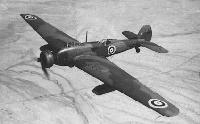Фотографии
-
Регистрационный номер: K4240 Handley Page's response to B9/32 was the HP.52 K4240. This entered production as the Hampden.
This view of the prototype H.P. 52 shows the small amount of wing dihedral.Самолёты на фотографии: Handley Page Hampden / H.P.52 - Великобритания - 1936
-
Регистрационный номер: K2771 [2] Both G4/31 interpretations performing at the Hendon Air Pageant, 1935. The G4/31 biplane (wearing the ‘New Types Park’ number 6) follows the monoplane PVO-9 ‘4‘.
Самолёты на фотографии: Vickers G.4/31 / Type 253 - Великобритания - 1934Vickers Wellesley - Великобритания - 1935
-
Регистрационный номер: K7556 The prototype B22/45 Wellesley, K7556, differed considerably from the private venture monoplane
Самолёты на фотографии: Vickers Wellesley - Великобритания - 1935
-
Регистрационный номер: L2645 Production Wellesley I L2645 was delivered to 14 Squadron in early 1938.
Самолёты на фотографии: Vickers Wellesley - Великобритания - 1935
-
Wellington of 9 Squadron, complete with the 'dust-bin' turret
Самолёты на фотографии: Vickers Wellington / Type 271 - Великобритания - 1936
-
Регистрационный номер: N2980 Recovered from the bottom of Loch Ness in September 1985, Wellington IA N2980 is now restored to its geodetic glory and on display at the Brooklands Museum.
Самолёты на фотографии: Vickers Wellington / Type 271 - Великобритания - 1936
-
Wellington I fuselages in the erecting shop at Weybridge in 1939, with front turrets designed by Wallis nearing completion.
Каркасы фюзеляжей "Веллингтонов" Mk.I на авиазаводе в Бруклендсе. Начало 1939г.Самолёты на фотографии: Vickers Wellington / Type 271 - Великобритания - 1936
-
The centre cell of the bomb hay of a Wellington showing two 250 lb bombs.
Самолёты на фотографии: Vickers Wellington / Type 271 - Великобритания - 1936
-
Регистрационный номер: K4049 [2] The Vickers B9/32 with glazed areas in the nose and tail.
Самолёты на фотографии: Vickers Wellington / Type 271 - Великобритания - 1936
-
Регистрационный номер: L4212 IN SERVICE SOON: A new view of the Pegasus-engined Vickers Wellington I medium bomber, which will before long be standard equipment in the R.A.F. There is a Nash and Thompson multi-gun turret in the nose and stern, and a third gun position amidships.
View of the prototype Wellington Mark I, L4212, first flown on December 23, 1937, from Brooklands with “Mutt" Summers in command. It was later converted to DWI status.Самолёты на фотографии: Vickers Wellington / Type 271 - Великобритания - 1936
-
Регистрационный номер: K4049 [2] The Vickers B9/32 K4049 at Brooklands, June 1936, wearing the Hendon 'New Types Park' number' T in front of the fuselage roundel.
Самолёты на фотографии: Vickers Wellington / Type 271 - Великобритания - 1936
-
TOP: Wellington IA. FRONT VIEW AND TOP view: Wellington IC. bottom: DWI Mk.I
Самолёты на фотографии: Vickers Wellington / Type 271 - Великобритания - 1936
-
Vickers B9/32.
Самолёты на фотографии: Vickers Wellington / Type 271 - Великобритания - 1936
-
Top: Wellington I prototype - plus scrap view of its tail, three-view: Production Wellington I with dustbin' turret shown in deployed position.
Самолёты на фотографии: Vickers Wellington / Type 271 - Великобритания - 1936
-
Регистрационный номер: K8178 The Vickers B1/35, K8178 - the Warwick prototype, in its initial phase with Rolls-Royce Vulture Ils, August 1939.
The prototype Warwick, K8178, was a harbinger of troubles to come.Самолёты на фотографии: Vickers Warwick - Великобритания - 1939
-
Регистрационный номер: K2771 [2] The biplane G4/31 K2771 ground-running at Brooklands in mid-1934. The fuselage used geodetics.
Самолёты на фотографии: Vickers G.4/31 / Type 253 - Великобритания - 1934
-
Personnel give scale to the Type 207, built to Specification M1/30. This short-lived 1933 prototype was Barnes Wallis's first ‘entire’ aircraft design
Самолёты на фотографии: Vickers Type 207 - Великобритания - 1933
Статьи
- Round-Out
- The Roundels File
- D.Willis - Battles for Power /Test-beds and experimentals/
- D.Willis - Extended Family /Post-war combat/ (1)
- E.Young - Ponderous Patrician /Airliners and air services/
- F.Mormillo - Chino 'Dogs' /History on the wing/
- F.Prins - Adaptable Stalwart /World war two/ (1)
- P.Dubois - South African Big Cats /Air forces/
















